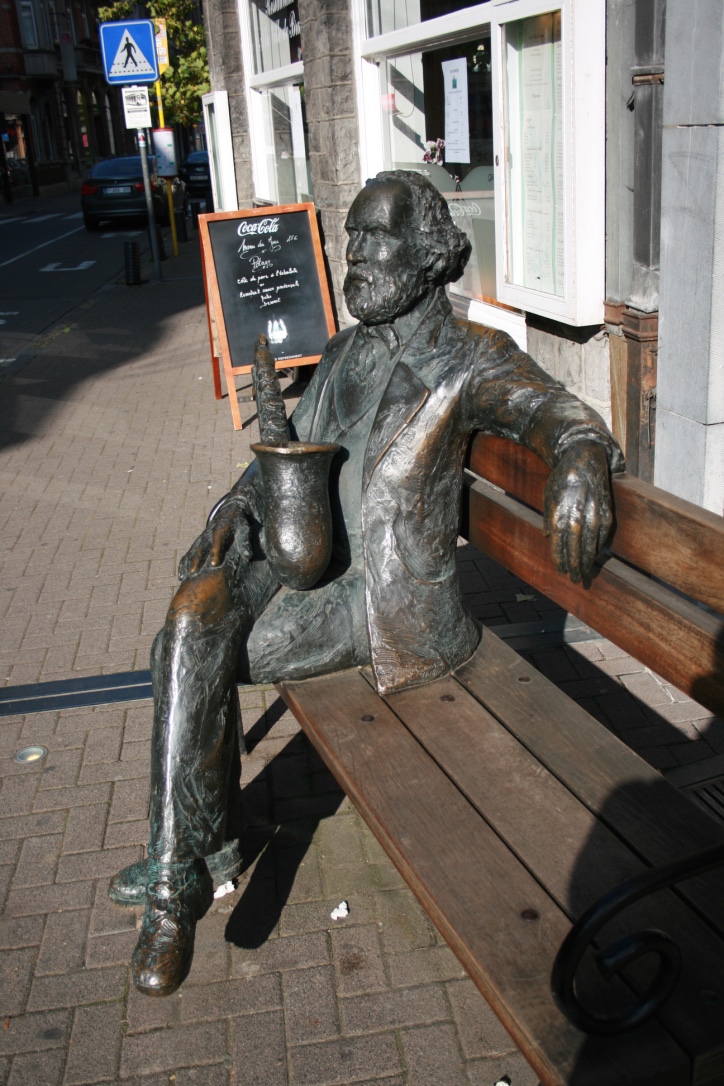Do you know who the inventor of the saxophone is?
The man who invented the saxophone was a man named Adolphe Sax.
He was born in 1814 in Dinant, a town in the west of Belgium.
He was born in 1814 in Dinant, a town in the west of Belgium. Dinant is a sacred place for those who play the saxophone.
In this article, I would like to introduce such a town, Dinant.
What kind of town is Dinant?
Dinant is a town in the southeast of Belgium, formed by the river Meuse.
As you can see in the picture below, it is a very picturesque place.

It is located about an hour and a half by car from Brussels, the capital of Belgium. There is also a train station, so it takes 1.5 to 2 hours to get there by train.
The area was already inhabited during the Neolithic period, and it became one of the major cities around the 11th century, and was a fiefdom of the Bishop of Liege until the end of the 18th century.
Dinant was considered an important place, and a castle was built to monitor the valley.
There are two reasons why Dinant was such an important place.
The production of brass products was so prolific around Dinant that it was called Dinandry (brass products), and
And because the Moose River was used for trade, it was also an important place in terms of logistics.
Since there were many brass products being made, the production of musical instruments using brass also became popular.
In fact, Adolphe Sax’s father, Charles Joseph Sax, was also a maker of musical instruments, and was credited with making the horn.
Let’s take a look at some of the places of interest in Dinant.
A Place to visit in Dinant, Notre Dame Church.
First, the church in the middle of the picture above. Notre Dame Church.

The church itself was first built in the 1200s, but was partially destroyed and rebuilt when a rock fell from the cliff behind it. It was originally Romanesque, but the Gothic style was added, giving it a distinctive look.

A Place to visit in Dinant, Citadel.
Next is the Citadel, a fort on the cliff behind the Notre Dame Church.
To get to the Citadel, climb the stairs next to the Notre Dame Church or take the cable car.

Climbing up to the top, you can see the whole town of Dinant and have a great view.
As soon as you get to the fort, you’ll see that it was used until World War I, so you’ll find everything from medieval artifacts to recent cannons.
A Place to visit in Dinant, “Adolph Sax Birthplace”.
Finally, let’s go down from the Citadel into the town of Dinant and go to Adolph Sax Street.
There is a bronze statue of Adolph Sachs sitting on a bench at the end of a monument of saxophone keys and saxophone shaped lights.

Behind it is a museum that was converted from Adolph Sax’s birthplace.
The museum is not very large, but it displays a variety of instruments, including the saxophone he invented, instruments that led up to the saxophone, and instruments other than the saxophone.
A Place to visit in Dinant, “Maison Leffe”.
Have you ever heard of the Belgian beer Leffe?
In fact, there is a place in Dinan where you can learn about the history of Leffe and taste some of their beers and enjoy the differences… Maison Leffe!
Maison Leffe
It was originally a brewery that was converted into a hotel and restaurant, and if you like Belgian beer, you should definitely visit this place.
It is located on the opposite side of the river from the Citadel and Notre Dame Church, and is a 10-minute walk from Dinan Station.
It’s on a little hill where you can see the other side of the river.
Food Recommendations in Dinant
In Dinant, there is the Couque de Dinant, a cookie that was invented around the 15th century as a preserved food for battles.
It is said to be the hardest cookie in Europe. It is made of flour and honey and is more often decorated than eaten these days.
Another recommended dish is “steamed mussels in wine”. You can find it in Brussels, Belgium.
Here, they are cooked with white wine and lots of vegetables, and you will be surprised to find that the amount for one person is so much more than you would ever eat in Japan.

By the way, Dinant is in the south of Belgium, so they spoke in French.
Sometimes English is not understood, so it is a good idea to look up the names of dishes and simple conversations during meals in French.
When I was there, “A white wine, please.” was not understood in a restaurant, but “Vin blanc, S’il vous plait”.


コメント